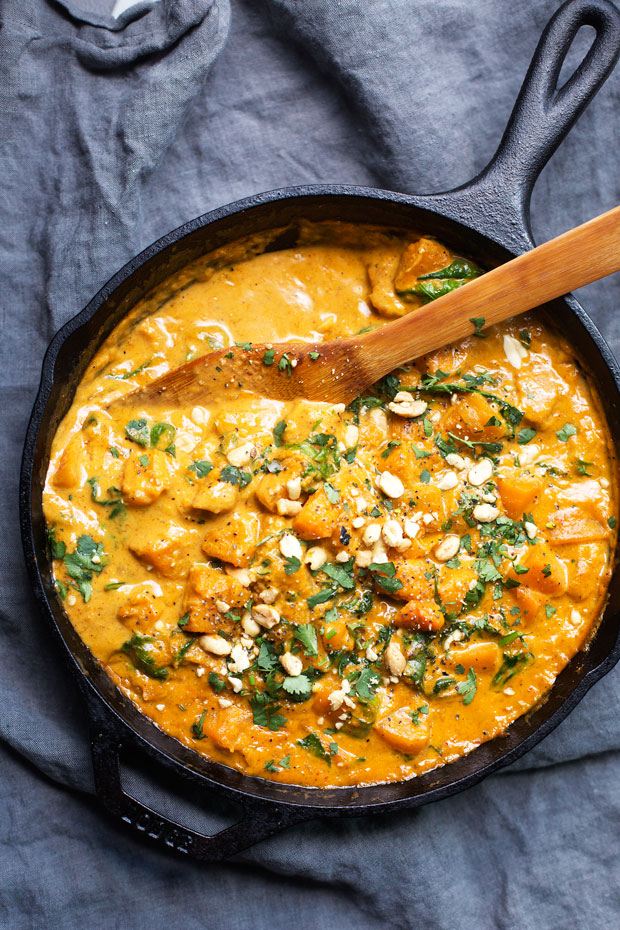And here it is! Thai butternut squash red curry has always been one of the most popular recipes on my blog. And the taste is incredible! Maybe it’s the fact that it’s loaded with vegetables, but it’s also very customizable? Like chickpeas? Throw in a can! Let it bubble and simmer away with thai curry paste until the whole house smells delicious. Top the curry recipe with fresh herbs like chopped cilantro and serve it up with brown rice or white rice. Thank goodness it’s butternut squash season again—AKA the best season there is, in my very humble opinion. Because, um… hello! Butternut squash red Thai curry is actually a thing. And it’s creamy, spicy, sweet, crunchy, comforting, and just downright addicting. Something I’ve been waiting all summer long to share. But who makes spicy curry in the summertime other than me? Everything we love about food in general all rolled into one easy curry recipe. What I need you to know is that this is weeknight curry. We’re using store-bought red curry paste and really amping up the flavor with a little yellow curry powder. WHAT. Yes friends. The yellow curry powder adds so much spice and flavor to this easy one-pot butternut squash curry.
How to Make Butternut Squash Curry:
Butternut squash curry ingredients:
Basmati Rice: You can also serve this with naan, quinoa, white rice, or brown rice! Coconut Oil: I like to cook curry recipes that naturally use coconut milk in coconut oil to help enhance the flavor. You could also use avocado oil or any other oil that you typically cook with. Shallots: I like to use shallots for most Thai recipes that I make. If you happen to have a red or yellow onion on hand, you could make that swap too! Butternut Squash: We’ll dice the squash and simmer it in the curry until it’s fork-tender! Even my never-vegetarian hubby loves this recipe! Fresh Ginger: We’ll add grated ginger to the curry to amp up the flavor. Red Curry Paste: Buy a good brand of red curry paste, as most of the flavor in this recipe comes from it. This is my favorite brand. Yellow Curry Powder: contains ingredients like cumin, turmeric, and other seasonings. You can use any mild yellow curry powder you like. Here’s what you need. Coconut Milk: I like to use full-fat coconut milk for this recipe, but a low-fat version will work too. Coconut milk helps thicken the curry, so this recipe is naturally gluten-free. Vegetable Broth or Chicken broth: This is what helps thin out the coconut milk and makes a delicious curry that you can spoon over your rice. Fish Sauce: adds umami to the recipe. Feel free to omit this if you follow a strict vegetarian or vegan diet. This is my favorite brand. Sugar: helps balance the salt in the recipe. Baby Spinach: adds color and is another source of fiber and nutrition.
Making Butternut Squash Curry:
Serve it up. Grab a bowl and load it up with your favorite rice or quinoa. Then top it with this freshly made, extremely fragrant curry recipe! Sprinkle some crushed peanuts or cashews on top and cilantro. Squeeze on fresh lime juice to really wake up the flavors! Saute the aromatics. Start by heating the oil in a skillet. Once melted, add the shallots and give them plenty of time to sweat down and become golden. Then, add the butternut squash and grated ginger. Simmer the curry. Once the butternut squash is well coated in the oil, we’ll add in the red curry paste and curry powder and stir until the squash cubes have a chance to get nicely coated in these ingredients. Continue to cook until the curry starts to get fragrant. Add the broth, coconut milk, fish sauce, and sugar. Bring the curry to a simmer, then lower the heat and allow the squash to cook until it’s completely fork-tender. You’ll know it’s done when a fork pierces through the cubes without any resistance. Stir in the baby spinach.
If you like this recipe, you might also like:
20-Minute Panang Chicken Curry Chicken Tikka Masala Creamy Coconut Curry with Shrimp and Corn Curried Butternut Squash Soup Finger Lickin’ Butter Chicken
Kale can be used in place of the spinach in this recipe but keep in mind you’ll need to add it in earlier so that it has enough time to wilt.





